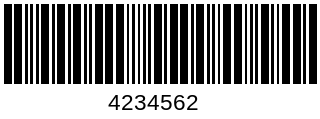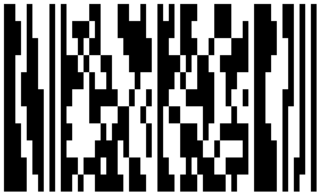While Hypertext Markup Language (HTML) has been in use since 1991, HTML 4.0 from December 1997 was the first standardized version where international characters were given reasonably complete treatment. When an HTML document includes special characters outside the range of seven-bit ASCII, two goals are worth considering: the information's integrity, and universal browser display.

In computing, plain text is a loose term for data that represent only characters of readable material but not its graphical representation nor other objects. It may also include a limited number of "whitespace" characters that affect simple arrangement of text, such as spaces, line breaks, or tabulation characters. Plain text is different from formatted text, where style information is included; from structured text, where structural parts of the document such as paragraphs, sections, and the like are identified; and from binary files in which some portions must be interpreted as binary objects.

A barcode or bar code is a method of representing data in a visual, machine-readable form. Initially, barcodes represented data by varying the widths, spacings and sizes of parallel lines. These barcodes, now commonly referred to as linear or one-dimensional (1D), can be scanned by special optical scanners, called barcode readers, of which there are several types.
ISO/IEC 8859-11:2001, Information technology — 8-bit single-byte coded graphic character sets — Part 11: Latin/Thai alphabet, is part of the ISO/IEC 8859 series of ASCII-based standard character encodings, first edition published in 2001. It is informally referred to as Latin/Thai. It is nearly identical to the national Thai standard TIS-620 (1990). The sole difference is that ISO/IEC 8859-11 allocates non-breaking space to code 0xA0, while TIS-620 leaves it undefined.

Code 39 is a variable length, discrete barcode symbology defined in ISO/IEC 16388:2007.
ISO/IEC 8859-9:1999, Information technology — 8-bit single-byte coded graphic character sets — Part 9: Latin alphabet No. 5, is part of the ISO/IEC 8859 series of ASCII-based standard character encodings, first edition published in 1989. It is designated ECMA-128 by Ecma International and TS 5881 as a Turkish standard. It is informally referred to as Latin-5 or Turkish. It was designed to cover the Turkish language, designed as being of more use than the ISO/IEC 8859-3 encoding. It is identical to ISO/IEC 8859-1 except for the replacement of six Icelandic characters with characters unique to the Turkish alphabet. And the uppercase of i is İ; the lowercase of I is ı.
ISO/IEC 8859-13:1998, Information technology — 8-bit single-byte coded graphic character sets — Part 13: Latin alphabet No. 7, is part of the ISO/IEC 8859 series of ASCII-based standard character encodings, first edition published in 1998. It is informally referred to as Latin-7 or Baltic Rim. It was designed to cover the Baltic languages, and added characters used in Polish missing from the earlier encodings ISO 8859-4 and ISO 8859-10. Unlike these two, it does not cover the Nordic languages. It is similar to the earlier-published Windows-1257; its encoding of the Estonian alphabet also matches IBM-922.

PDF417 is a stacked linear barcode format used in a variety of applications such as transport, identification cards, and inventory management. "PDF" stands for Portable Data File. The "417" signifies that each pattern in the code consists of 4 bars and spaces in a pattern that is 17 units (modules) long. The PDF417 symbology was invented by Dr. Ynjiun P. Wang at Symbol Technologies in 1991. It is defined in ISO 15438.

Code 128 is a high-density linear barcode symbology defined in ISO/IEC 15417:2007. It is used for alphanumeric or numeric-only barcodes. It can encode all 128 characters of ASCII and, by use of an extension symbol (FNC4), the Latin-1 characters defined in ISO/IEC 8859-1. It generally results in more compact barcodes compared to other methods like Code 39, especially when the texts contain mostly digits. Code 128 was developed by the Computer Identics Corporation in 1981.

A Data Matrix is a two-dimensional code consisting of black and white "cells" or dots arranged in either a square or rectangular pattern, also known as a matrix. The information to be encoded can be text or numeric data. Usual data size is from a few bytes up to 1556 bytes. The length of the encoded data depends on the number of cells in the matrix. Error correction codes are often used to increase reliability: even if one or more cells are damaged so it is unreadable, the message can still be read. A Data Matrix symbol can store up to 2,335 alphanumeric characters.
Extended Channel Interpretation (ECI) is an extension to the communication protocol that is used to transmit data from a bar code reader to a host when a bar code symbol is scanned. It enables the application software to receive additional information about the intended interpretation of the message contained within the barcode symbol and even details about the scan itself. ECI was developed as a symbology-independent extension of the Global Label Identifier (GLI) system used in the PDF417 bar code.
ISO-IR-111 or KOI8-E is an 8-bit character set. It is a multinational extension of KOI-8 for Belarusian, Macedonian, Serbian, and Ukrainian. The name "ISO-IR-111" refers to its registration number in the ISO-IR registry, and denotes it as a set usable with ISO/IEC 2022.

ITF-6 is the implementation of an Interleaved 2 of 5 (ITF) barcode to encode a addon to ITF-14 and ITF-16 barcodes. Originally was developed as a part of JIS specification for Physical Distribution Center. Instead of ITF-14, it wasn’t standardized by ISO Committee but it is widely used to encode additional data to Global Trade Item Number such as items quantity or container weight.
Barcode library or Barcode SDK is a software library that can be used to add barcode features to desktop, web, mobile or embedded applications. Barcode library presents sets of subroutines or objects which allow to create barcode images and put them on surfaces or recognize machine-encoded text / data from scanned or captured by camera images with embedded barcodes. The library can support two modes: generation and recognition mode, some libraries support barcode reading and writing in the same way, but some libraries support only one mode.

Industrial 2 of 5. is a variable length, discrete, two width symbology. Industrial 2 of 5 is a subset of two-out-of-five codes.

Matrix 2 of 5 is a variable length, discrete, two width symbology. Matrix 2 of 5 is a subset of two-out-of-five codes. Unlike Industrial 2 of 5 code, Matrix 2 of 5 can encode data not only with black bars but with white spaces.

MicroPDF417 is two-dimensional (2D) stacked barcode symbology invented in 1996, by Frederick Schuessler, Kevin Hunter, Sundeep Kumar and Cary Chu from Symbol Technologies company. MicroPDF417 consists from specially encoded Row Address Patterns (RAP) columns and aligned to them Data columns encoded in "417" sequence which was invented in 1990. In 2006, the standard was registered as ISO/IEC 24728:2006.

Han Xin code is two-dimensional (2D) matrix barcode symbology invented in 2007 by Chinese company The Article Numbering Center of China to break monopoly of QR code. As QR code, Han Xin code consists of black squares and white square spaces arranged in a square grid on a white background. It has four finder patterns and other markers which allow to recognize it with camera-based readers. Han Xin code contains Reed–Solomon error correction with ability to read corrupted images. At this time, it is issued as ISO/IEC 20830:2021.

DotCode is two-dimensional (2D) matrix barcode invented in 2008 by Hand Held Products company to replace outdated Code 128. At this time, it is issued by Association for Automatic Identification and Mobility (AIM) as “ISS DotCode Symbology Specification 4.0”. DotCode consists of sparse black round dots and white spaces on white background. In case of black background round dots, creating barcode, can be white. DotCode was developed to use with high-speed industrial printers where printing accuracy can be low. Because DotCode by the standard does not require complicated elements like continuous lines or special shapes it can be applied with laser engraving or industrial drills.

Rectangular Micro QR Code is two-dimensional (2D) matrix barcode invented and standardized in 2022 by Denso Wave as ISO/IEC 23941. rMQR Code is designed as a rectangular variation of QR code and has the same parameters and applications as original QR code. But rMQR Code is more suitable for the rectangular areas and has difference between width and height up to 19 in R7x139 version. In this way it can be used in places where 1D barcodes are used. rMQR Code can replace Code 128 and Code 39 barcodes with more effective data encoding.
















